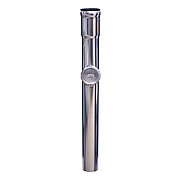LORO-X Steel discharge pipes behind the facade
backflow-proof, break-proof, pressure-resistant and approved for internal areas
Whether internal gutter drainage or parapet drainage, more and more downpipes are being laid behind the facade and in the thermal insulation composite system for optical reasons.
Not every pipe is suitable for this. This is where backflow-proof, break-proof and pressure-resistant LORO-X steel drainage pipes show their strengths, as they are also approved for interior areas.
![[Translate to EN:] LORO-X Attikaentwässerung mit Druckströmung hinter der Fassade verlegt [Translate to EN:] LORO-X Attikaentwässerung mit Druckströmung hinter der Fassade verlegt](/fileadmin/_processed_/3/7/csm_HINTER_DER_FASSADE_bee3f6a45b.jpg)
Inside and yet outside
The downpipes behind the facade combine the advantages of internal with external drainage:
1. no openings through the roof
2. no visible downpipe in front of the facade!
LORO-X pressure drainage with small nominal widths are ideal in this case (e.g. DN 50 or DN 70).
![[Translate to EN:] LORO-X Reinigungsöffnung hinter der Fassade [Translate to EN:] LORO-X Reinigungsöffnung hinter der Fassade](/fileadmin/_processed_/d/3/csm_W17TB0006_fa06766313.jpg)
Cleaning opening
According to DIN1986-100, a cleaning opening is also required before the rainwater is discharged into the ground pipe.
This could become a problem for downpipes in the facade as most of the cleaning openings in the rain standpipes do not protrude far enough.
This problem can be solved by using a LORO-X 87° branch and a LORO-X threaded cupling with screw cap.
Practical tips
1. Since the insulation is weakened in the area where the downpipe is laid into the thermal insulation composite system, a strip with higher-quality insulation should be placed behind the pipe so that the dew point in this area is not shifted into the outer wall of the building.
2. In accordance with DIN 1986-100 and in consultation with the client, a trace heating should be provided on site in areas threatened by frost to ensure that the line freezes to protect the facade. The trace heating should not be installed in pipelines smaller than DN 70. Otherwise the cross-section of the pipeline will be too small. In this case, an external trace heating system should be considered.
3. In order to ensure the backflow security of the connection points of the downpipe in buildings, the connection points should additionally be provided with anchor clips.



